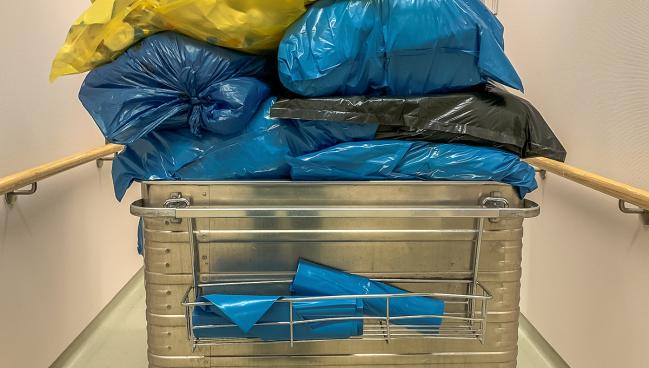Mountains of Cath Lab Waste Could Be Recycled, Study Estimates
The author of the single-center study says averting environmental damage should be as innate to physicians as CV prevention.

US cardiac catheterization laboratories are throwing out a lot of paper and plastic waste that could otherwise be recycled, a single center’s experience suggests, indicating that there’s a big opportunity to reduce interventional cardiology’s carbon footprint.
Harsh Doshi, MD (Thomas Jefferson University Hospital, Philadelphia, PA), and colleagues report that across 5 days and 70 cases, their cath lab produced 52.6 kg (116 lbs) of uncontaminated, potentially recyclable materials. The amount per case was greatest for PCI.
Extrapolating these results to the roughly 965,000 PCIs done each year in the US, the researchers estimate that at least 1.36 million kg (3 million lbs) of paper and plastic waste that could be recycled after these procedures instead ends up in landfills.
Doshi, a fellow with plans to go into interventional cardiology, is set to present the findings as a poster at the upcoming American College of Cardiology/World Congress of Cardiology (ACC/WCC) 2023 meeting. He took a long-term view when discussing the implications of what they found.
“We’re making all of these amazing advancements in medicine, but I want to be in a world that’s habitable for me and future generations to see these advancements,” he told TCTMD. “Like any sort of change—whether it be changes to your diet, lifestyle, personal growth, or even cath lab skill set—you need to start forming good habits, because these habits are what’s going to make a visible difference down the road.”
Everybody grows up learning about the importance of recycling, “so why has this suddenly stopped in medicine and in cardiology?” Doshi continued. “If this is a career I’m going into and it’s a place where I’m going to be spending most of my time, I have a responsibility as a citizen of the world to try to do my part in limiting environmental waste as best as possible.”
Scope of the Problem
Since the field of medicine is so data-driven, he said, a key first step to addressing the problem of excess waste in the cath lab was quantifying the problem. For the project, Doshi met with cath lab technicians, nursing staff, and nursing administrators to come up with a way to separate potentially recyclable materials without interrupting workflows, and then over a 5-day period, Doshi himself collected and weighed what was collected after each procedure.
What he found was that “there is a lot of waste that we are contributing to our environment that we just don’t really pay too much attention to.”
We’re making all of these amazing advancements in medicine, but I want to be in a world that’s habitable for me and future generations to see these advancements. Harsh Doshi
Overall, the paper and plastic waste collected each day weighed an average of 10.5 kg (23 lbs), or 0.72 kg (1.59 lbs) per case. The average weight per procedure was highest for PCI at 1.41 kg (3.11 lbs) and lowest for right heart catheterization at 0.66 kg (1.46 lbs).
These figures underestimate the amount of paper and plastic waste generated by cath labs, Doshi noted, because certain types of procedures, like TAVI and other structural heart interventions, were excluded.
Thinking Bigger for the Future
With these results—soon to be published as a research letter—in hand, the time is right to make a push with hospital administrators to address waste coming out of the cath lab, Doshi said. “This is a problem and we need to come up with a sustainable solution long term.”
It’s not just an environmental issue, he added, pointing to research showing that hospitals that have implemented programs to reduce energy use and waste actually save money over the years. “It’s not only environmentally friendly, but also financially friendly for your hospital,” Doshi said.
He said a major obstacle to implementing recycling in the cath lab, however, is that hospitals—his center included—are not set up to dispose of recyclables separate from other trash, so it all ends up in the landfill. That represents one avenue of opportunity to address this issue.
Another is through working with industry to make changes to how they package the devices and other materials cath lab staff use on a regular basis, Doshi said.
The hope is that this study will raise awareness of the problem of medical waste and inspire other centers to take a look at what’s getting thrown away in their cath labs, and at the same time cause hospital administrators to take a serious look at the benefits of implementing a recycling program and possibly establishing a “green team” dedicated to the promotion of environmentally sustainable practices, Doshi indicated.
“Unfortunately, this isn’t something that’ll be solved overnight,” he said.
Small Study, Huge Ramifications
Commenting for TCTMD, Chandan Devireddy, MD (Emory Healthcare, Atlanta, GA), said the study, although conducted at a single cath lab, provides information that is “very impactful for all of us working in the cardiac catheterization space. . . . The amount of waste generated is pretty eye-opening.”
It’s reasonable to extrapolate these results to the country at large, he added. “It’s a very elegant, simple project, but I think the ramifications are huge.”
Indeed, Doshi and colleagues note, about 5.9 million tons of waste are generated from US healthcare facilities each year. And they hint that the problem may have grown worse during the COVID-19 pandemic, during which there has been greater demand for single-use plastics.
Devireddy pointed to inertia, the challenges of separating out biohazardous materials, the difficulties of disposing of multiple waste streams, and potentially up-front costs as barriers to implementing cath lab recycling programs more broadly, but he suggested that centers should be more forward-looking as the focus on environmental sustainability in all aspects of life, including healthcare, becomes more intense over time. “If this is coming down the pike, where we’re going to have to be held accountable for waste and carbon we’re generating, is there a benefit to kind of getting on top of it now?” he asked.
For Doshi, the answer is clear. “Oftentimes, this stuff that we don’t see immediate results in gets lost, but as cardiologists we need to focus on preventative care for our environment just like we do for our patients,” he said. “I’d rather start curbing the issue now when it’s a 40% LAD lesion, before it becomes an untreatable multivessel CTO and the patient’s in cardiogenic shock and it’s too complex to fix. I think we need to treat our environment [with] the same mindset that we go along with treating our patients.”
Todd Neale is the Associate News Editor for TCTMD and a Senior Medical Journalist. He got his start in journalism at …
Read Full BioSources
Doshi H. Recyclable waste in the cardiac catheterization laboratory: the potential to curb the carbon footprint. To be presented at: ACC/WCC 2023. March 5, 2023. New Orleans, LA.
Disclosures
- Doshi reports no relevant conflicts of interest.





Comments